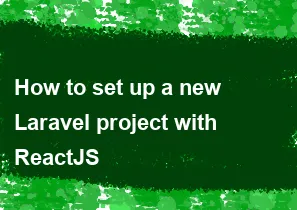How to set up a new Laravel project with ReactJS

Setting up a new Laravel project with ReactJS involves a few steps. Laravel provides a great foundation for building robust backend applications, while ReactJS is a powerful JavaScript library for building user interfaces. Combining the two allows you to create modern, dynamic web applications. Here's a step-by-step guide:
Step 1: Install Laravel
If you haven't installed Laravel yet, you can do so using Composer. Open your terminal and run:
bashcomposer create-project --prefer-dist laravel/laravel your-project-name
Replace your-project-name with the desired name for your Laravel project.
Step 2: Set up Database
Configure your database settings in the .env file located in the root of your Laravel project.
envDB_CONNECTION=mysql DB_HOST=127.0.0.1 DB_PORT=3306 DB_DATABASE=your_database_name DB_USERNAME=your_database_username DB_PASSWORD=your_database_password
Run the migration to create the necessary database tables:
bashphp artisan migrate
Step 3: Install Laravel Passport (Optional)
If you plan to use Laravel Passport for API authentication, you can install it using:
bashcomposer require laravel/passport php artisan migrate php artisan passport:install
Step 4: Install Laravel Mix
Laravel Mix simplifies asset compilation. Install it with:
bashnpm install
Step 5: Install React
Install React and other required packages using npm:
bashnpm install react react-dom react-router-dom
Step 6: Create React Components
Create React components in the resources/js/components directory. For example, create a file ExampleComponent.js:
jsx// resources/js/components/ExampleComponent.js
import React from 'react';
const ExampleComponent = () => {
return (
<div>
<h1>Hello, React!</h1>
</div>
);
}
export default ExampleComponent;
Step 7: Use React Components in Blade Views
In your Blade views (e.g., resources/views/welcome.blade.php), include the React components using the react and react-dom scripts:
php<!-- resources/views/welcome.blade.php -->
<!DOCTYPE html>
<html>
<head>
<!-- Other head elements -->
<script src="{{ mix('js/app.js') }}" defer></script>
</head>
<body>
<div id="app"></div>
<script>
import React from 'react';
import ReactDOM from 'react-dom';
import ExampleComponent from './components/ExampleComponent';
ReactDOM.render(<ExampleComponent />, document.getElementById('app'));
</script>
</body>
</html>
Step 8: Compile Assets
Run the following command to compile your assets:
bashnpm run dev
Step 9: Serve Your Application
Finally, run your Laravel development server:
bashphp artisan serve
Visit http://localhost:8000 in your browser, and you should see your Laravel application with ReactJS integrated.
Remember that this is a basic setup, and you may need to expand it based on your project requirements. Additionally, consider using more advanced tools like Laravel Sanctum or Laravel Jetstream for user authentication and a more feature-rich development environment.
-
Popular Post
- How to optimize for Google's About This Result feature for local businesses
- How to implement multi-language support in an Express.js application
- How to handle and optimize for changes in mobile search behavior
- How to handle CORS in a Node.js application
- How to use Vue.js with a UI framework (e.g., Vuetify, Element UI)
- How to configure Laravel Telescope for monitoring and profiling API requests
- How to create a command-line tool using the Commander.js library in Node.js
- How to implement code splitting in a React.js application
- How to use the AWS SDK for Node.js to interact with various AWS services
- How to use the Node.js Stream API for efficient data processing
- How to implement a cookie parser middleware in Node.js
- How to implement WebSockets for real-time communication in React
-
Latest Post
- How to implement a dynamic form with dynamic field styling based on user input in Next.js
- How to create a custom hook for handling user interactions with the browser's device motion in Next.js
- How to create a custom hook for handling user interactions with the browser's battery status in Next.js
- How to implement a dynamic form with dynamic field visibility based on user input in Next.js
- How to implement a dynamic form with real-time collaboration features in Next.js
- How to create a custom hook for handling user interactions with the browser's media devices in Next.js
- How to use the useSWRInfinite hook for paginating data with a custom loading indicator in Next.js
- How to create a custom hook for handling user interactions with the browser's network status in Next.js
- How to create a custom hook for handling user interactions with the browser's location in Next.js
- How to implement a dynamic form with multi-language support in Next.js
- How to create a custom hook for handling user interactions with the browser's ambient light sensor in Next.js
- How to use the useHover hook for creating interactive image zoom effects in Next.js